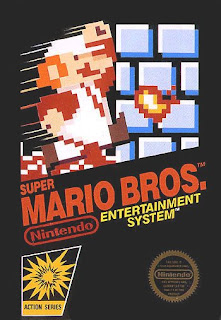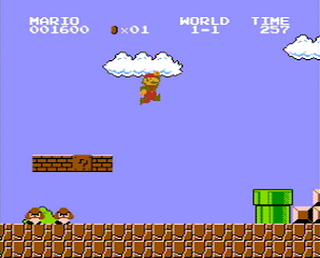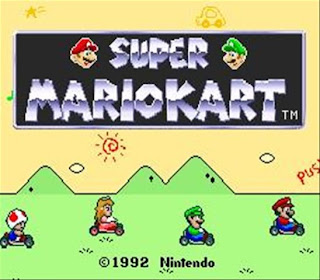According to an interview between Satoru Iwata and the creators Mario Kart, Super Mario Kart, the first in the series, didn’t start off as a Mario game at all. Super Mario Kart started as an attempt to create a racing game where two players could play at the same time. The prototype for this game featured a man in overalls, and about 3 months after testing the game, the staff decided it looked neat if the character was Mario racing around. And the rest is history. Today, the Mario Kart franchise features six games, each one home to a different Nintendo platform. Though each game is different the core Mario Kart experience remains the largely same. For the purposes of this essay, I will illustrate the structural similarities between the platforming game Super Mario Bros. and the Mario Kart games specifically Super Mario Kart for the Super Nintendo Entertainment System.
Both Super Mario Bros. and Super Mario Kart are all about racing. Mario races to the end of each level against the clock in Super Mario Bros., while kart driving characters (henceforth referred to as Karts) race to the end of each level against each other in Super Mario Kart. To successfully manage this race, Mario and Karts feature a set of tight, well tuned controlling mechanics complete with accelerator buttons. Holding the B button makes Mario run faster accelerating into his top speed. It is the same for the Karts except that the Karts generally use the A button. Like with any body of mass, both Mario and Karts gain momentum with increasing speeds. While Mario skids to a stop, the karts skid or drift around turns.

Mario overcomes obstacles with the use of his legendary jumping skills allowing him to hop up hills, leap over pits, and jump out of the way of danger when his momentum would have otherwise resulted in a collision. Analogously, Karts can also jump. The feather item from Super Mario Kart gives players the ability to spring over hazards, players, and even walls creating short cuts and possibilities out of thin air. This feather jump ability parallels Mario’s jump. Sadly, this item was not included in any future Mario Kart game. For the rest of the Mario Kart games (excluding Double Dash) players can hop. Hopping does everything Mario’s jump does, but on a smaller scale. By hopping into the air and then turning left or right, the player can sharply adjust their turning angle avoiding hazards at high speeds or narrowly adjusting one’s racing path. Also, hopping can be used to jump over cracks or other pitfalls. Unlike normal vehicles in more traditional racing games, go-karts are personal. Their small size and weight allows them to be scooted around by the driver. When run up against a wall, instead of reversing like in a normal vehicle, Karters can simply scoot or hop their Karts to adjust themselves.
In the Mario Bros. 2D platforming series Mario obtains a variety of powerups that are presented in context to Mario’s situation. If Mario is small, hitting the right question block will release a mushroom. If Mario is already big, then Mario will receive a fire flower powerup. Depending on the game, and the context of Mario’s state, different powerups will come up. Likewise, in all the Mario Kart games, players will receive different items depending on their rank in the race. Players at the top will receive single bananas, fake item boxes, and a green shell here and there while players at the bottom are more likely to get lightenings, golden mushrooms, spiny shells, stars, and other items that help them fight their way back to the top.

One of the highest levels of design in Super Mario Bros. is how the levels and the strategies needed to overcome its obstacles transform dynamically and uniquely with every one of Mario’s powerup transformations. When Mario is small, everything is dangerous. One hit will do him in. He also doesn’t even have the strength to bust through bricks. But when Mario is big, the player can afford to take a few risks, get hit by an enemy, and live to tell the tale. But what is most dynamic about being big Mario is, by destroying bricks, Mario is transforming the platforms on the level. For a platforming game, this is significant. If you don’t like the way you have to jump around a certain brick formation to get to the top, then use your jump and make your own formation. The fire flower powerup transforms the level in a different way. Using the fire projectiles from a distance gives Mario the ability to take out enemies from a far without endangering himself. When Mario had to jump over enemies before, now he can blast right through them. This powerup is limited in the number of fireballs Mario can launch at a time, and by the angle at which Mario throws them. Because the balls are angled down at about a 45 degree angle, enemies directly in front and above him are still a threat. In order to take out such enemies, Mario must climb ever higher to compensate. The only way Mario can get higher is by using his jump, the primary function of the game. In this way, the powerups allow players to overcome the same obstacles in the game in new ways while staying true to the core of the game. Thus what was present before is transformed.
In Super Mario Kart, each item is a powerup that transforms the level in new ways while staying focused on the primary mechanic: kart racing. The green shells fire in a straight line. Racers who attempt to hit their opponents to slow them down must first line up their shot. Doing this while racing around a track isn’t easy, but the player must also factor in how their opponent is racing. This alone emphasizes a knowledge and execution of racing, the primary function of the Mario Kart series. And it goes further. Green shells bounce back off of the walls that enclose the racing course. If you’re not careful, your green shell may come back to strike you. But, if you’re really good, you’ll use this knowledge to your advantage and ricochet your shells into your opponents.
Red shells home opponents, but this doesn’t take aiming off of the players hands. If players don’t launch these shells with caution, they can easily be nullified on walls or other obstacles before the homing path kicks in. Also, the homing feature of these shells also makes them predictable and easier to counter. Because the shell will travel along the course towards the closet target ahead of the player, it’s possible to turn in such a way as to make the shell run into a wall. Depending on the game, some red shells home better than others. Some are faster. Some can be out raced at top speed. Some jump over bumps and small gaps. Other fall and are never seen again. Knowing just how the red shell will operate is key. And if a player has a red shell coming in fast, avoiding it puts their racing skills to the test.
Bananas are a simple yet powerful item in Mario Kart. Running over one can cause a Kart to slip up and careen away. Slipping and sliding into a wall or off a cliff can be devastating depending on the level and the circumstances. Knowing where to best place a banana requires knowledge of the course and how your opponents race on any particular level. The best part about this item is that it stays on the track until something collides with it. Leaving behind a banana can turn a normal turn into a tricky turn or even a deadly one. Seeing a banana down the road can easily force a player to adjust their racing paths on the fly to avoid slipping out. Bananas also have stopping power against green and red shells. If someone is aiming for you, drop a banana or hold it behind your kart to thwart their efforts. This move is the easiest way to counter shell attacks or aggressive Karters that want to bump you from behind. Taking the risk to steer into a banana field can even provide protection from incoming attacks. Such strategies recycle bananas for use that continually feeds into the dynamics of the race: attacking, defending, and most importantly racing.
The final item I want to discuss is the mushroom powerup. This item gives the Kart a temporary boost in speed that isn’t effected by rough terrain like dirt and grass. This feature gives the player the ability to cut across what would otherwise be inefficient paths and sections of a course thus create short cuts and new paths. The sharp increase in speed also allows a light weight kart to bump heavier karts turning the tables on the weight balance for a small moment. Knocking others out of the way, or taking the less traveled path to victory are two ways the mushroom can transform track.
In Super Mario Bros. Mario can take a fatal hit from a humble goomba. Because platforming is all about jumping, and jumping involves Mario's physical space and momentum against the environment, it is only fitting that mismanaging ones physical space by running Mario against an enemy results in a penalty. It is even more fitting that jumping directly on top of most enemies conquers them. The margin between a hit or a miss is clearly defined within the game rules and the form the game has for all of the enemies and the environment. The tight controls coupled with a clear relationship of space for all the objects in the game create a very clean experience.
In the Mario Kart series, space is similarly defined. As I have mentioned previously, though the player steers a go-kart around, the hopping mechanic brings a level of self to the game. It is impossible to associate with the vehicle as opposed to the character in the vehicle, because the character driving the go-kart is so highly visible and because the hop is such a well integrated mechanic in the core gameplay. Picking a character in Mario Kart, or in any Mario game, is important because of how their individual character traits are reflected in the gameplay. Mario Kart keeps a close personal level of interaction by allowing karts to bump or ram each other like they would in go-kart racing. The bumping interacting creates depth through character weights. The terrifying koopa Bowser is the heaviest character in Mario Kart: Super Circuit. When bumping shoulder to shoulder with any other character in the game, Bowser stays on course while the other character is veered, at times, violently to the side. A relatively safe journey across a bridge can becomes deadly when Bowser is racing next to you. The bumping interaction makes every player aware of each other’s space in relation to the track.
For the 2D platforming Mario games, the whole game is designed around the primary mechanic: jump. It is impossible to beat the game without jumping. In fact, it’s impossible to get through the first 10 seconds of Super Mario Bros. without jumping. That lonely goomba makes the importance of jumping very clear from the start. The way Super Mario Bros. is designed is to provide as many interesting situations for the jumping player, which includes using knowledge of jumping, ducking, standing still, sliding, walking, and running. Each of these control mechanics and elements are designed tightly together to support jumping. Understanding the intricacies and dynamics of these mechanics takes time and practice. Instead of forcing the player to jump, the player is encouraged with coins. Go ahead. Jump up and grab them. Some coins are easy to get, while other coins require some risk and skill to obtain. Collecting 100 coins rewards the player with an extra life. And the player who is attempting to beat the game knows that the more lives they have the better chances they have of beating the game. As the player continues to play through the game, they’ll get better at collecting coins, and subsequently, better at jumping; the core of the game. As players exercise their skills, they’re rewarded with more lives, which allows them to go father and practice getting coins and beating levels towards the end of the game where things get progressively harder. It’s a cycle that sustains, and rewards players over time.
Super Mario Kart and Mario Kart: Super Circuit are the only Mario Kart games that feature coins. Lying on the track of each course are many coins. Just like in Super Mario Bros. these coins encourage the player to play differently. This time, the player is encouraged to take different paths along the tracks. Each coin is positioned in a way to encourage good racing. In the same way that the designers of Super Mario Bros. never placed a single coin in a pit where players would have to fall to their doom to obtain, the coins in theses two Mario Kart games are placed in areas to encourage a deeper understanding of the tracks and racing mechanics. Having more coins increases the overall racing speed of the Kart. This alone encourages players to nab as many as possible. Coins are also used for a defense and a penalty for driving off course. With each bump between Karts, a coin is lost for each player. If a player has no coins and is bumped, they spin out as if hit from a shell. If the player drives off of the course, a Lakitu will pick them up and place them back on the track charging a few coins for his services. In these ways, by seeking and collecting coins, players become better racers with better chances of survival just like in Super Mario Bros.
Just like with Super Mario Bros. The accumulation of all the small elements in Super Mario Kart amass into a perfectly designed game. With perfect controls, well defined space, and a dedication to the primary function, both games have made their mark on history. Miyamoto commented in an interview with Satoru Iwata that the Mario games aren't too different from Zelda games. Structurally, many of Nintendo's greatest games are built the same way: A strict adherance to the primary function, tight controls, forms that fit their function, and a game world that is alive with transformations. Throw in Mario characters and classic Mario items, and it's no wonder Super Mario Bros. and Super Mario Kart are so similar.
